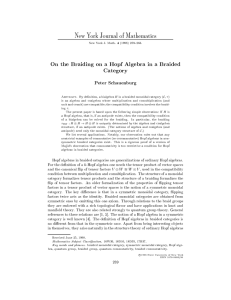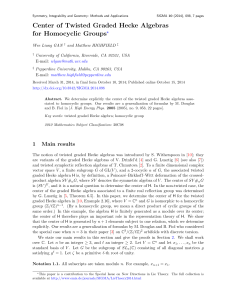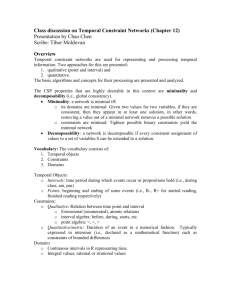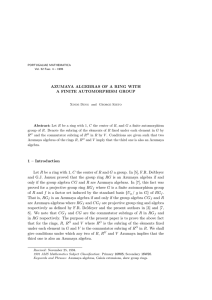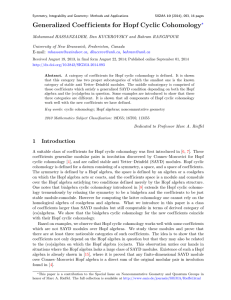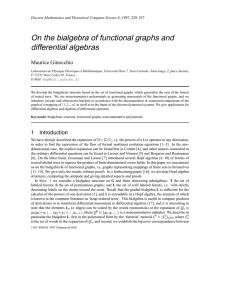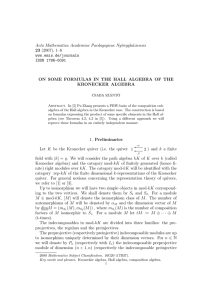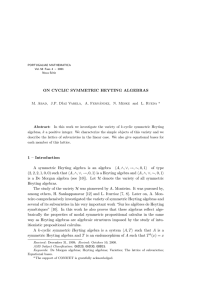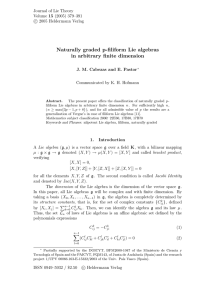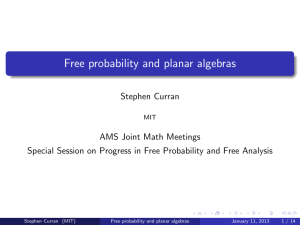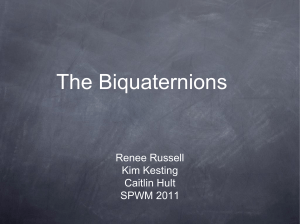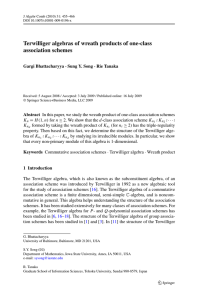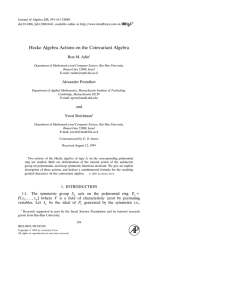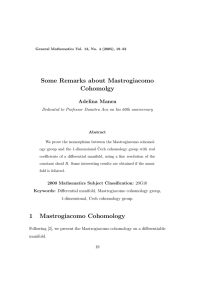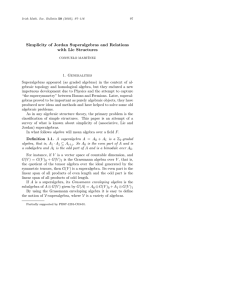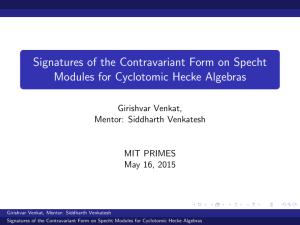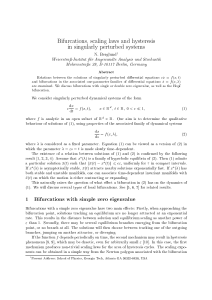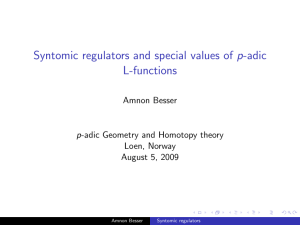Lie-Hopf algebras and their Hopf cyclic cohomology Bahram Rangipour
advertisement
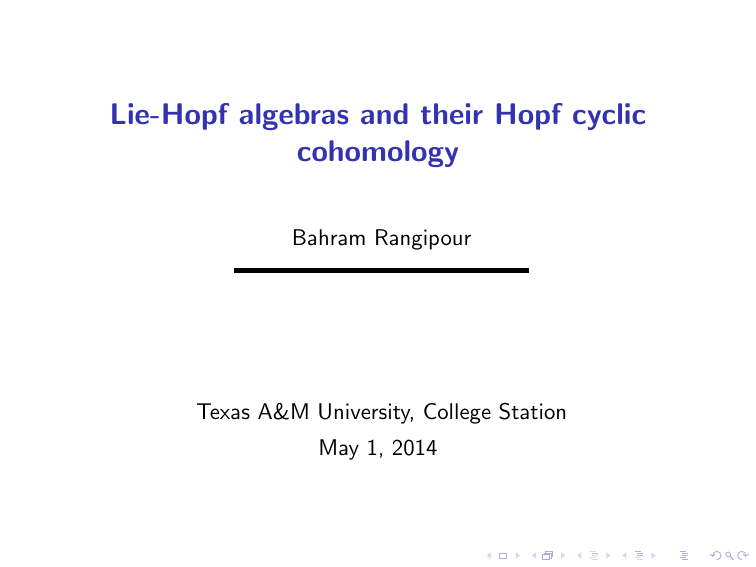
Lie-Hopf algebras and their Hopf cyclic
cohomology
Bahram Rangipour
Texas A&M University, College Station
May 1, 2014
.
.
.
.
.
.
Local Index Formula in NCG
Theorem (Connes-Moscovici, 1995)
For
∫ an (odd) spectral triple (A, H, D) such that the residues
− T := Ress=0 Tr(s ℓ T |D|−2s ), T ∈ {A, [D, c], |D|−z ; z ∈ C}
ℓ
make sense, one has:
[(φn )n=1,3,... ] is a cocycle in the (b, B)-bicomplex of A,
0
n
φn (a , . . . , a ) =
∑
k,ℓ
∫
cn,k,ℓ − a0 [D, a1 ](k1 ) . . . [D, an ](kn ) |D|−n−2|k|
ℓ
∇(T ) = [D 2 , a], T (k) = ∇k (T ), |k| = k 1 + . . . + k n ,
(
)
(−1)|k| Γ(ℓ) |k| + n2
cn,k,ℓ =
.
k1 ! . . . kn !(k1 + 1) . . . (k1 + · · · + kn + n)
.
.
.
.
.
.
Theorem (Connes-Moscovici 1998)
I
For any n ≥ 1 and any oriented flat manifold M n , there is a
canonical Hopf algebra Hn acting on the algebra
An := Cc∞ (FM) >▹ Diff(M).
I
There is a canonical cyclic cohomology theory, associated to
Hn , canonically isomorphic to the Gelfand Fuks cohomology
of the Lie algebra of formal vector fields on Rn .
I
There is a characteristic map from the mentioned cyclic
cohomology of Hn to the cyclic cohomology of the algebra An
such that the index cocycle is trapped in its image.
.
.
.
.
.
.
Modular pair in involution
Let H be a Hopf algebra.
I
An algebra map δ : H → C is called a character
I
An element σ ∈ H is called a group-like if ∆(σ) = σ ⊗ σ
I
The pair (δ, σ) is called modular pair in involution (MPI) if
δ(σ) = 1 and
e 2 (h) = σhσ −1
S
δ
eδ (h) = ∑ δ(h(1) )S(h(2) )
Here S
.
.
.
.
.
.
Hopf cyclic cohomology, HC (H, σ Cδ )
We define operators b and B,
b :=
q+1
∑
H ⊗q o
(
(−1)i di ,
B :=
i=0
q
∑
b
/
H ⊗q+1
B
)
sq−1 (1 − t).
(−1)qi t i
i=0
where
d0 (h1 ⊗ . . . ⊗ hq ) = 1 ⊗ h1 ⊗ . . . ⊗ hq ,
∑
di (h1 ⊗ . . . ⊗ hq ) =
h1 ⊗ . . . ⊗ ∆(hi ) ⊗ . . . ⊗ hq ,
dq+1 (h1 ⊗ . . . ⊗ hq ) = h1 ⊗ . . . ⊗ hq ⊗ σ,
sj (h1 ⊗ . . . ⊗ hq ) = h1 ⊗ . . . ⊗ ε(hj+1 ) ⊗ . . . ⊗ hq ,
∑
eδ (h1(2) ) · (h2 ⊗ . . . ⊗ hq ⊗ σ),
t(h1 ⊗ . . . ⊗ hq ) =
S
where H acts on H ⊗q diagonally.
.
.
.
.
.
.
Action of Hopf algebras on algebras
The same way that groups or Lie algebras act on algebras by
automorphisms or derivations respectively, we want Hopf algebras
act on algebras. In this case we say an algebra A is H-module
algebra if
h ◃ (ab) =
∑
(h(1) ◃ a)(h(2) ◃ b),
h ◃ 1A = ε(h)1A
.
.
.
.
.
.
Characteristic map
Suppose a Hopf algebra H acts on an algebra A. Provided for a
MPI (δ, σ) the algebra A obtains a δ-invariant σ-trace, τ : A → C,
i.e
(
)
τ h(a) = δ(h)τ (a),
(
)
τ (ba) = τ aσ(b)
there is a characteristic map
χτ : HC • (H, σ Cδ ) → HC • (A)
χτ (h1 ⊗ . . . ⊗ hn )(a0 ⊗ . . . ⊗ an )) = τ (a0 h1 (a1 ) · · · hn (an ))
.
.
.
.
.
.
Crossed product algebra
Let M be a manifold and Γ ≤ Diff M.
One defines the left action of Γ on C ∞ (M) by
ϕ ◃ f = f ◦ ϕ−1
Define the crossed product algebra
C ∞ (M) >▹ Γ
∑
A typical element is a finite sum of i f i Uϕ∗i where fUϕ∗ stands for
f >▹ ϕ−1 .
Multiplication reads as
2
∗
f 1 Uϕ∗1 f 2 Uϕ∗2 = f 1 (ϕ−1
2 ◃ f )Uϕ2 ϕ1
.
.
.
.
.
.
The Hopf algebra Hn
I
Let M = Rn . Vector fields on FM are generated by
Yji := yjk
I
∂
,
∂yki
Xk = yki
∂
∂x i
We lift them on An := Cc∞ (FM) >▹ Γ by
Xk (fUφ∗ ) = Xk (f )Uφ∗ ,
Yji (fUφ∗ ) = Yji (f )Uφ∗
I
We have Yji (ab) = Yji (a)b + aYji (b),
I
However, for Xk we have
i
Xk (ab) = Xk (a)b + aXk (b) + δj,k
(a)Yij (b)
,
I
i (fU ∗ ) = γ i (φ)fU ∗ , and
Here δjk
φ
φ
jk
[
]i
i
γjk
(φ)(x, y ) = y −1 · φ′ (x)−1 · ∂µ φ′ (x) · y j ykµ
.
.
.
.
.
.
continued ...
I
One defines the higher order operators δj,k|l
by
1 ,...,lm
I
I
δj,k|l
= [Xlm , δj,k|l
]
1 ,...,lm
1 ,...,lm−1
i
i
i δµ − δi δµ
− δjl|k
= δµl
They satisfy the Bianchi identities δjk|l
µk jl
jk
Definition
As an algebra Hn is the subalgebra of L(An ) generated by Xk , Yji
I
and all δj,k|l
. The comultiplication of Hn is obtained by the
1 ,...,lm
Leibniz rule h(ab) = h(1) (a) h(2) (b), h ∈ Hn , a, b ∈ An .
So we see that
i
⊗ Yij
∆(Xl ) = Xl ⊗ 1 + 1 ⊗ Xl + δj,l
∆(Yji ) = Yji ⊗ 1 + 1 ⊗ Yji
i
i
i
∆(δj,k
) = δj,k
⊗ 1 + 1 ⊗ δj,k
.
.
.
.
.
.
Actions of Hn on AΓ (FM)
I
Hn acts on AΓ (FM)
I
AΓ (FM) possesses the trace
∫
f ϖFM
∗
FM
τ (fUφ ) =
0
I
if φ = id
otherwise
The character on Hn defined by
δ(Yji ) = δji ,
δ(Xl ) = 0,
δ(δji0 j1 |j2 ,...,jm ) = 0
.
.
.
.
.
.
Structure of Hn
I
Xk , Yji form a representation of g := g ℓaffine
n
I
i
∗
δj,k|ℓ
generates F := U(a+
n)
1 ,...,ℓm
I
(
)
U(g), F forms a matched pair of Hopf algebras
(
)cop
Hn = U(g) I▹ F
.
.
.
.
.
.
Past progress ([Moscovici-R])
C • (H, Cδ )
χτ
/ C • (AΓ )
O
O
I
• (a)
Ctop
ELH
/ C •,• (g∗ , F)
c−w
Φ
/ C • (Ω)
Bott
Θ
.
.
.
.
.
.
•,•
Cc−w
(g.∗ , F)
..
.O
..
O
∂c−w
..
.O
∂c−w
∧2O g∗
bc−w
∂c−w
/ (∧2 g∗ ⊗ ∧2 F)F
O
∂c−w
bc−w
∂c−w
gO ∗
bc−w
∂c−w
C
bc−w
/ ...
∂c−w
bc−w
/ (g∗ ⊗ ∧2 F)F
O
∂c−w
bc−w
/ (∧2 g∗ ⊗ ∧3 F)F
O
/ (g∗ ⊗ ∧3 F)F
O
bc−w
/ ...
bc−w
/ ...
∂c−w
bc−w
/ (C ⊗ ∧2 F)F
/ (C ⊗ ∧3 F)F
,
bc−w (α ⊗ f 0 ∧ · · · ∧ f q ) = α ⊗ 1 ∧ f 0 ∧ · · · ∧ f q ,
∂c−w (α ⊗ f 0 ∧ · · · ∧ f q ) =
∑
∂α ⊗ f 0 ∧ · · · ∧ f q −
θi ∧ α ⊗ Xi ◃ (f 0 ∧ · · · ∧ f q ).
i
.
.
.
.
.
.
We now define a multiplication on the bicompplex
p,q
Ccoinv
(g∗ , F) := (∧p g∗ ⊗ F ⊗q+1 )F .
p,q
r ,s
p+r ,q+s
Ccoinv
⊗ Ccoinv
→ Ccoinv
,
(ω1 ⊗ f 0 ⊗ . . . ⊗ f q ) ∗ (ω2 ⊗ g 0 ⊗ . . . ⊗ g s )
= ω1 ∧ ω2 ⊗ f 0 ⊗ . . . ⊗ f q−1 ⊗ f q g 0 ⊗ g 1 ⊗ . . . ⊗ g s
Let us now define the graded multiplication
(ω1 ⊗ f˜) · (ω2 ⊗ g̃ ) = (−1)qr (ω1 ⊗ f˜) ∗ (ω2 ⊗ g̃ )
and eventually we use the canonical projection
π : F ⊗(q+1) → ∧q+1 F to define the multiplication on
•,•
(g∗ , F), by which it becomes a commutative DG algebra.
Cc−w
.
.
.
.
.
.
Hopf version of universal connection and curvature
1,0
i
ωji := θji ⊗ 1 + θk ⊗ ηj,k
∈ Cc−w
(g∗ , F)
1,1
i
Ωij := θk ⊗ 1 ∧ ηj,k
∈ Cc−w
(g∗ , F)
.
.
.
.
.
.
i
i
∂T (Ωij ) = −θl ∧ θlk ⊗ 1 ∧ ηj,k
− θl ∧ θk ⊗ 1 ∧ ηj,k|l
i
s
− θjr ∧ θk ⊗ 1 ∧ ηri ,k + θkr ∧ θk ⊗ 1 ∧ ηj,r
+ θsi ∧ θk ⊗ 1 ∧ ηj,k
.
ωki · Ωkj
k
i
k
i
k
= θki ∧ θp ⊗ 1 ∧ ηj,p
+ θl ∧ θp ⊗ ηk,l
⊗ ηj,p
− θl ∧ θp ⊗ ηk,l
ηj,p
⊗ 1.
Ωik · ωjk
i
i
k
i
k
= −θl ∧ θjk ⊗ 1 ∧ ηk,l
− θl ∧ θp ⊗ 1 ⊗ ηk,l
ηj,p
+ θl ∧ θp ⊗ ηk,l
⊗ ηj,p
.
In other words
∂T (Ωij ) = Ωik · ωjk − ωki · Ωkj
.
.
.
.
.
.
Similarly we have,
i
i
∂T (ωji ) = −θjk ∧ θki ⊗ 1 − θℓ ∧ θℓk ⊗ ηjk
− θℓ ∧ θk ⊗ ηj,k|ℓ
q
i
i
i
− θjp ∧ θk ⊗ ηp,k
+ θqi ∧ θk ⊗ ηj,k
− θkp ∧ θk ⊗ ηj,p
− θk ⊗ 1 ∧ ηj,k
On the other hand we have
ωki · ωjk =
i
k
i
k
+ θℓ ∧ θp ⊗ ηk,l
ηj,p
θki ∧ θjk ⊗ 1 + θℓ ∧ θjk ⊗ ηk,ℓ
+ θki ∧ θp ⊗ ηj,p
We see that
∂T (ωji ) = −Ωij + ωki · ωjk
.
.
.
.
.
.
Weil Algebra
The truncated Weil algebra Ŵ := ⊕p,q≥0 Ŵ p,2n is recalled as
follows.
q
Ŵ p,2q = Ap (gln ) ⊗ S2n
(gln )
It is the commutative DG algebra generated by the connection
elements Tji of degree 1 and the curvature elements Rji of degree 2.
dTji = −1 ⊗ Rji + Tki ∧ Tjk ⊗ 1,
dRji = Tjk ⊗ Rki − Tki ⊗ Rjk
.
.
.
.
.
.
Hopf-Weil basis
By the universal property of Ŵ (g ℓn ) we define the following DG
algebra map
r +k,k ∗
L : Ŵ (r ,2k) (g ℓn ) → Cc−w
(g , F)
(1)
L(Tji ) = ωji ,
(2)
L(Rji ) = Ωij
Theorem
r +k,k ∗
The map L : Ŵ (r ,2k) (g ℓn ) → Cc−w
(g , F) defined above is a
quasi-isomorphism.
.
.
.
.
.
.
Lie-Hopf Algebras
We first introduce the setting.
I
F is a commutative Hopf algebra.
I
g is a finite dimensional Lie algebra.
I
g acts on F by derivations, : g ⊗ F → F.
I
F coacts on g, H : g → g ⊗ F.
For a fixed basis {X1 , · · · , XN } of g, we write the coaction as
H : Xi 7→ Xj ⊗ fi j .
.
.
.
.
.
.
Lie-Hopf Algebras
j
For the element fi,k
:= Xk fi j , we say the coaction H : g → g ⊗ F
satisfies the structure identity of g if
fj,ik − fi,jk =
∑
s,r
k r s
Cs,r
fi fj +
∑
l k
Ci,j
fl
l
Finally we introduce an action of g on F ⊗2 as
X • (f ⊗ g ) := X <0> f ⊗ X <1> g + f ⊗ X g .
.
.
.
.
.
.
Lie-Hopf Algebras
Definition
We say F is a g−Hopf algebra if
(A) Coaction H : g → g ⊗ F satisfies the structure identity of g,
(B) Coalgebra structure of F is g−equivariant, i.e.
∆(X f ) = X • ∆(f ),
ε(X f ) = 0.
and
Theorem
F is a g−Hopf algebra if and only if (F, U(g)) is a matched pair of
Hopf algebras meach means F I▹ U(g) is a Hopf algebra.
.
.
.
.
.
.
Coinvariant Lie subalgebra and Hopf algebra
Thanks to (A)
{
}
g0 := gF := X ∈ g | H(X ) = X ⊗ 1 ,
is a Lie algebra.
And because of (B)
F0 := Fg :=
F
⟨g ◃ F⟩
is a Hopf algebra
.
.
.
.
.
.
Cartan calculus for Lie-Hopf algebras
For any Y ∈ g0 we define the contraction ιY and the Lie derivative
LY on C •,• (g∗ , F).
ιY (ω⊗ f˜) = ιY (ω)⊗ f˜,
LY (ω⊗ f˜) = LY (ω)⊗ f˜ +ω⊗Y ◃ f˜. (3)
(a) The contraction ιY is a derivation of degree −1.
(b) The Lie derivative LY is a derivation of degree 0.
(c) LX = ∂T ιY + ιY ∂T
(d) [∂T , LY ] = 0
(e) L[Y1 ,Y2 ] = [LY1 , LY2 ]
(f) [ιY1 , LY2 ] = ι[Y1 ,Y2 ]
.
.
.
.
.
.
Weil homomorphism
Let α : g∗0 → g∗ be a (algebraic) Cartan connection i.e.
α ◦ adY = adY ◦α,
ιY (α(ω)) = ω(Y ).
1,0
We extend α to α : g∗0 → Cc−w
(g∗ , F) by
α(ω) = (α(ω))<0> ⊗ (α(ω))<−1> .
•,•
The extension of α defines a Cartan connection on Cc−w
(g∗ , F).
As a result we get a map of g0 -DG algebras
•,•
Cα : ∧• g∗0 ⊗ S • (g∗0 )[2q] → Cc−w
(g∗ , F)
Here q = dim g − dim g0 .
.
.
.
.
.
.
Classical geometries
Geometry
1. General
2. Vol preserving
Automorphism group
Structure group
Diff(Rn )
Diff Vol
GLn
(Rn )
SLn
3. Symplectic
Diff Sp (R2n )
Sp2n
4. Contact
Diff Cn (R2n+1 )
Cn2n+1
.
.
.
.
.
.
Geometries and the corresponding Hopf algebras
( )
CΓ∞ M) := Cc∞ (M) >▹ Γ
Geometry
Lie alg.
Hopf alg.
Iso. Lie alg.
Algebra
General
an
Hn
g ℓn
(
)
CΓ∞ F + (Rn )
Vol pres.
san
SHn
sℓn
(
)
CΓ∞ Fs+ (Rn )
Sympl.
sp2n
SpH2n
sp2n
( + 2n )
CΓ∞ Fsp
(R )
Contact
Fn2n+1
CnH2n+1
cn2n+1
( + 2n+1 )
CΓ∞ Fcn
(R
)
.
.
.
.
.
.
The quantum symmetry of AΓ := Cc∞ (Rn ) o Γ
∂
,
∂x i
Xk (fUϕ∗ ) = Xk (f )Uϕ∗ ,
I
Xk =
I
For Xk we have
Xk (ab) = Xk (a)b +
I
Here
σki (fUϕ∗ ) =
∑
σki (a)Xi (b)
∂ϕi ∗
fU
∂x k ϕ
and higher derivatives
σji1 ,...,jk (fUϕ∗ ) =
∂ k ϕi
fU ∗
∂x j1 · · · ∂x jk ϕ
.
.
.
.
.
.
The Hopf algebra Kn
We let the Hopf algebra Kn be the subalgebra of L(AΓ generated
by
Xℓ , σji1 ,...,jm , σ −1
here σ = det[σji ] is the Jacobi automorphism of AΓ .
Its Hopf algebra structure is
∆(Xl ) = Xl ⊗ 1 + σlk ⊗ Xk ,
∆(σji ) = σjk ⊗ σki ,
∆(σ) = σ ⊗ σ,
∆(σ −1 ) = σ −1 ⊗ σ −1 ,
∆(σji1 ,...,jk ) = [∆(Xjk ), ∆(σji1 ,...,jk−1 )],
ε(σ) = ε(σ −1 ) = 1,
ε(σji ) = δji ,
ε(Xl ) = ε(σji1 ,...,jk ) = 0.
.
.
.
.
.
.
Action of Kn on AΓ
I
Kn acts on AΓ
I
AΓ possesses the trace
τ (fUφ∗ )
−1
I σ C
I
I
=
∫
f ϖRn
if φ = id
0
otherwise
Rn
defines a MPI module on Kn
τ is a σ −1 trace
χτ : HC • (Kn ,σ
−1
C) → HC • (AΓ )
.
.
.
.
.
.
−1
HC (Kn ,σ C)
There is a map of algebras
•,•
•,•
Cc−w
(V ∗ , FK ) → Cc−w
(g ∗ , g ℓn , FK )
That induces
HP • (Kn ;σ
−1
C) ∼
= HP • (Hn , g ℓn ; Cδ )
Theorem
Hopf cyclic cohomology of Kn with coefficients in
all Chern classes.
.
.
σ −1 C
.
consists of
.
.
.
1,1
i
Ω̂ij = θk ⊗ 1 ∧ S(γjp )γp,k
∈ Cc−w
(V ∗ , FK )
( •,•
)
HP m Cc−w
(V ∗ , FK ) =
⊕
⟨Tr(Ω̂i1 ) · · · Tr(Ω̂ik )⟩
i1 +···+ik =m
.
.
.
.
.
.
For n = 1 we have the following b + B cocycles in HC 1 (K1 ,σ
C0 := 1 ⊗ σ −1 X1 ∈
1
C1 := 1 ⊗ σ −2 σ1,1
∈
σ −1
−1
C)
C ⊗ K1 ,
σ −1
C ⊗ K1
.
.
.
.
.
.
For n = 2 we have the following b + B cocycles in HC 2 (K2 ,σ
−1
C)
C0 := 1 ⊗ σ −1 σ2i X1 ⊗ σ −1 Xi − σ −1 σ1i X2 ⊗ σ −1 Xi ,
s
s
C1 := 1 ⊗ σ −1 σ2i S(σsj )σj,1
⊗ σ −1 Xi − σ −1 σ1i S(σsj )σj,2
⊗ σ −1 Xi ,
s
k
⊗ σ −1 S(σkr )σs,t
⊗
C2 := 1 ⊗ σ −1 S(σri )σ1t σi,2
s
k
− σ −1 S(σri )σ2t σi,1
⊗ σ −1 S(σkr )σs,t
,
s
(C1 )2 := 1 ⊗ σ −1 S(σsi )σ1t σi,2
⊗ σ −1 S(σkr )σrk,t
s
− σ −1 S(σsi )σ2t σi,1
⊗ σ −1 S(σkr )σrk,t .
.
.
.
.
.
.
A surprise
χτ : HC • (Kn ,σ
−1
C) → HC • (AΓ )
is not injective.
For n=1
χτ (C1 ) = 0
For n=2
χτ (C1 ) = χτ (C12 ) = 0
.
.
.
.
.
.
